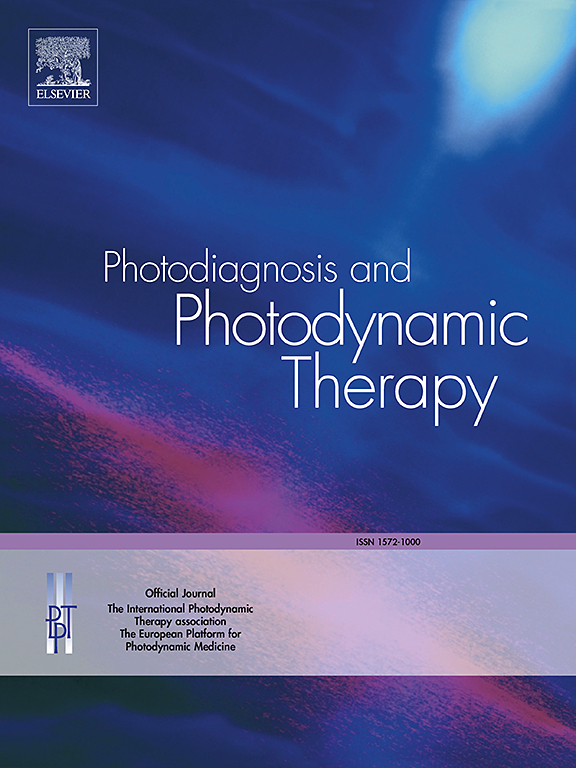Canal disinfectants: Potassium titanyl phosphate laser, magnesium oxide nanoparticles, and aloe-emodin PDT on smear layer removal and bond strength of glass fiber post to root dentin
IF 3.1
3区 医学
Q2 ONCOLOGY
引用次数: 0
Abstract
AIM
To assess the influence of different root canal disinfectants i.e., Potassium titanyl phosphate laser (KTPL), Aloe-emodin (AE) mediated Photodynamic therapy (PDT), Magnesium oxide (MgO) nanoparticles (NPs) on smear layer (SL) removal and push out bond strength (PBS) of Glass fiber post (GFP) to the canal dentin.
MATERIAL AND METHOD
Forty-eight extracted premolars, having a single root and a solitary canal were included. A root canal procedure was performed on each tooth and subsequently, post-space preparation was executed using peeso-reamers leaving approximately 4 mm of gutta percha in the canal. According to the type of disinfection used the samples were categorized into 4 groups (n = 11). Group 1 (2.5 % NaOCl + EDTA), Group 2 (KTPL+ EDTA), Group 3 (AE mediated PDT+ EDTA), and Group 4 (MgONPs+ EDTA). Cementation of fiber posts was performed using a self-adhesive resin cement. Scanning electron microscope (SEM) assessed the SL removal from the canals (n = 2). Failure mode and PBS were assessed with a stereomicroscope and universal testing machine respectively(n = 10). One-way analysis of variance and Tukey posthoc test at p-value ≤ 0.05 were used to compare the mean scores of PBS and SL removal.
RESULT
The cervical region in Group 4 (MgONPs + EDTA) samples showed the highest PBS scores (10.41±0.38 MPa) and the maximum level of SL removal (1.55±0.10). Conversely, Group 3 at the apical third of the root (AE mediated PDT +EDTA) displayed the least efficacy for SL removal (2.81±0.09) and lowest PBS(7.69±0.19 MPa).
CONCLUSION
MgO nanoparticles, when paired with Ethylenediaminetetraacetic acid as a final irrigant, offer a promising alternative to conventional root canal sterilants.
根管消毒剂:磷酸钛基钾激光、氧化镁纳米粒子和芦荟大黄素对玻璃纤维桩与根牙本质黏结强度的影响。
目的:探讨磷酸钛酸钾激光(KTPL)、芦荟大黄素(AE)介导的光动力疗法(PDT)、氧化镁(MgO)纳米颗粒(NPs)等不同根管消毒剂对玻璃纤维桩(GFP)与根管牙本质黏结层(SL)去除及推出强度(PBS)的影响。材料与方法:拔除的前磨牙48颗,均为单根单根根管。在每颗牙齿上进行根管手术,随后使用peeso- repper进行间隙准备,在根管内留下约4毫米的杜胶。按消毒方式将样品分为4组(n = 11)。组1 (2.5% NaOCl + EDTA)、组2 (KTPL+ EDTA)、组3 (AE介导的PDT+ EDTA)、组4 (MgONPs+ EDTA)。纤维桩的胶结使用自粘树脂水泥进行。扫描电镜(SEM)评估SL从根管中移除(n=2)。分别用体视显微镜和万能试验机评估失效模式和PBS (n=10)。PBS和SL去除的平均得分比较采用单因素方差分析和p值≤0.05的Tukey后验检验。结果:第4组(MgONPs + EDTA)的PBS评分最高(10.41±0.38 MPa), SL去除水平最高(1.55±0.10)。相反,第3组(AE介导的PDT + EDTA)在根尖三分之一处去除SL的效果最低(2.81±0.09),PBS最低(7.69±0.19MPa)。结论:MgO纳米颗粒与乙二胺四乙酸配对作为最终冲洗剂,是传统根管灭菌剂的一个有希望的替代方案。
本文章由计算机程序翻译,如有差异,请以英文原文为准。
求助全文
约1分钟内获得全文
求助全文
来源期刊

Photodiagnosis and Photodynamic Therapy
ONCOLOGY-
CiteScore
5.80
自引率
24.20%
发文量
509
审稿时长
50 days
期刊介绍:
Photodiagnosis and Photodynamic Therapy is an international journal for the dissemination of scientific knowledge and clinical developments of Photodiagnosis and Photodynamic Therapy in all medical specialties. The journal publishes original articles, review articles, case presentations, "how-to-do-it" articles, Letters to the Editor, short communications and relevant images with short descriptions. All submitted material is subject to a strict peer-review process.
 求助内容:
求助内容: 应助结果提醒方式:
应助结果提醒方式:


